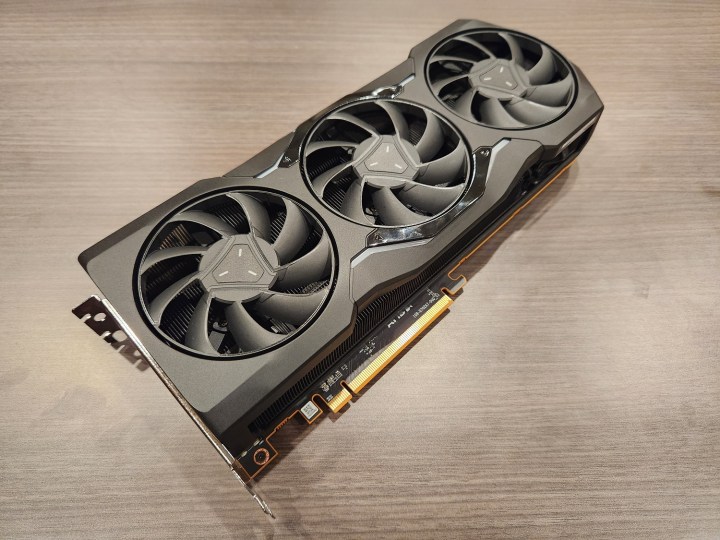If you’re looking for a budget GPU, the general advice is usually to buy from the previous generation of graphics cards. After all, as the new cards take over the market, the older ones are still waiting to be sold — and while they’re no longer among the best graphics cards, they’re still perfectly acceptable alternatives.
We’ve now reached the point in the current generation of Nvidia GPUs where that advice no longer applies. If you want to get the best bang for your buck, it’s time to stop buying Nvidia’s RTX 30-series and look for other options.
The RTX 30-series arrived at the worst possible time
 Jacob Roach / Digital Trends
Jacob Roach / Digital TrendsNvidia’s RTX 30-series arrived at a difficult time for many gamers. Launched during the pandemic and at the height of the GPU shortage, the GPUs sold like hotcakes, but often ended up in the hands of scalpers and crypto miners instead of those wanting to use them in a gaming PC.
Get your weekly teardown of the tech behind PC gaming
It was rough. Shoppers were faced with the difficult decision of buying a graphics card at an inflated price from a scalper or not buying one at all. Of course, you could always stand in line for an entire night when Best Buy had one of its GPU drops, too, but if that wasn’t an option, you were out of luck.
Having lived through it, the situation was pretty crazy, and cards along the likes of the RTX 3090 were highly sought after. Fortunately, Nvidia started releasing versions with lite hash rate (LHR) limiters that made them less viable for mining cryptocurrencies. (Miners found their way around them in record time, but I digress.)
These difficulties made it so that many of these cards, while excellent in their own right, were never given the time to shine in the mainstream spotlight because most of us just couldn’t get our hands on them.
Things started improving gradually, though, and over time, the RTX 30 series climbed in popularity. A quick look through the Steam Hardware Survey tells us that Nvidia’s RTX 3060 is currently king, but the RTX 4060 is not far behind. Nvidia dominates the top 10, and Ampere holds an even split with Ada.
The arrival of the RTX 40-series cast a new light on its predecessors. Widely considered expensive across the entire lineup, the Ada Lovelace generation of GPUs served to push the prices of the RTX 30-series down. Often more affordable at that point and sometimes close in performance, those GPUs made sense to buy if you didn’t care about DLSS 3. Even just a few months ago, I’d have recommended a few of the RTX 30-series cards as viable options to save money.
Not anymore. With the prices the way they are right now, you’re almost always better off buying a different GPU. Let me show you what I mean.
Expensive, not in stock, or not worth it
 Jacob Roach / Digital Trends
Jacob Roach / Digital TrendsI keep a close eye on GPU prices, and there’s been a steady shift in the pricing of the RTX 30 series. While some cards are still somewhat reasonable, many others are either overpriced or straight-up gone from the shelves. To illustrate the problem, let’s compare the current pricing of new Ampere graphics cards to their MSRP (manufacturer’s suggested retail prices).
| MSRP | Current price | |
| RTX 3050 | $250 | $165 |
| RTX 3060 | $330 | $280 |
| RTX 3060 Ti | $400 | $290 |
| RTX 3070 | $500 | $635 |
| RTX 3070 Ti | $600 | $660 |
| RTX 3080 | $700 | $750 |
| RTX 3080 Ti | $1,200 | $840 |
| RTX 3090 | $1,500 | $1,240 |
| RTX 3090 Ti | $2,000 | $1,575 |
The prices are a bit all over the place, which isn’t exactly unusual. Some of these GPUs are now over four years old, and all of them are no longer being produced. Many cards dropped below their MSRPs, but some, like the RTX 3070, have actually gone up.
The then-overpriced RTX 3080 Ti came back down to a more reasonable level, but unfortunately, that still doesn’t make it worth the money in the current GPU climate. The RTX 3090 Ti is now more affordable — if that word still applies to something that costs $1,600 — but, again, that doesn’t make it a good deal.
I’ll explain why below, but first, we’ll have a look at the prices of the current-gen equivalents of the above GPUs.
| MSRP | Current price | |
| RTX 4060 | $300 | $290 |
| RTX 4060 Ti 8/16GB | $400/$500 | $385/$440 |
| RTX 4070 | $600 | $560 |
| RTX 4070 Super | $600 | $580 |
| RTX 4070 Ti | $800 | $750 |
| RTX 4070 Ti Super | $800 | $790 |
| RTX 4080 | $1,200 | $1,700 |
| RTX 4080 Super | $1,000 | $990 |
| RTX 4090 | $1,600 | $2,175 |
This is where the issue lies. Nvidia’s RTX 40-series is almost entirely under or at MSRP now, which is great news. The only outlier is the RTX 4090, which is now crazy expensive because of factors like high demand for AI GPUs and the U.S. export ban on China — but that doesn’t make the RTX 3090 Ti a worthwhile alternative. The RTX 4080 has been replaced by the Super refresh, so it’s basically out of stock, hence the ridiculous price tag.
The RTX 4090, while expensive, turned out to be 68% faster than the RTX 3090 Ti, and a massive 89% faster than the base RTX 3090. At this point, it hardly matters how much the 30-series equivalents cost. If you’re spending well over $1,000 on a GPU, it’s much better to spend that money on a card that’s nearly twice as fast and provides access to Nvidia’s frame generation, which is only available in the RTX 40-series.
One might say that there’s a big gap between spending $1,600 to buy an RTX 3090 Ti and shelling out $2,200 for an RTX 4090, and while that’s right, you can save money by just getting the RTX 4080 Super. In our review of the base model, we found that the 4080 is 29% slower than the RTX 4090, but it’s also 22% faster than the RTX 3090 Ti — at a whopping $600 less.
This same kind of argument applies to the majority of the RTX 30 lineup. Some cards are at a similar price point, but the gen-on-gen gains combined with the power of frame generation allow the RTX 40-series to pull ahead in almost every scenario. And even though many people leave DLSS 3 off now, it might be a game-changer if you’re like me and don’t plan to upgrade for a few years. Once the tech matures even more and becomes available in more titles, it’ll certainly be worth the extra $50 to $100 you’ll spend on an RTX 40-series card.
 Jacob Roach / Digital Trends
Jacob Roach / Digital TrendsThe above chart demonstrates why DLSS 3 remains such a strong selling point for Nvidia, and why it’ll be a tough act to follow for DLSS 4, whenever that comes around. With frame generation, the $560 RTX 4070 runs at a stable 73 frames per second (fps) in Cyberpunk 2077, and that’s at 4K and on max settings. Meanwhile, the last-gen RTX 3070 Ti — now $660 — delivers a completely unplayable experience at 6 fps. Even the pricier RTX 3080 Ti can’t break 20 fps.
Don’t get me wrong: The RTX 4070 isn’t a 4K GPU, and DLSS 3 doesn’t turn it into one, but it certainly helps with future-proofing.
Generational gains between the RTX 30-series and the RTX 40-series aren’t great across the board. Some cards barely move the needle, and the RTX 4060 Ti is actually slower than its predecessor in some tests, which makes it a GPU to try to avoid most of the time. But even then, you’re most likely better off buying the RTX 4060 just for access to frame generation instead of spending the same amount of money on an RTX 3060 Ti. (On the other hand, it’s worth remembering that in pure rasterization, the RTX 4060 is slower than the RTX 3060 Ti.)
To wrap this up, if there’s one card that’s still somewhat worth buying from this generation, it’s the RTX 3060 Ti. Everything else is now either too expensive or not worth it when compared to its next-gen counterparts.
GPUs to consider instead of the RTX 30-series
 Jacob Roach / Digital Trends
Jacob Roach / Digital TrendsSo, if the RTX 30-series is no longer an option, what else can you buy? Tough question, but only because I don’t know your budget.
The market is flush with excellent GPUs that are up for grabs at MSRP. The truth is that not all last-gen stuff is bad — AMD still has a bunch of solid cards in the RDNA 2 lineup, and many of them are dirt cheap at this point. For Nvidia, your best bet is to buy current-gen GPUs. Intel only has one generation of cards, but it shouldn’t be disregarded.
If I had to pick one GPU to recommend from the RTX 40-series, it’d definitely be the — read our review to find out why. It’s a top-notch GPU that outpaces a large portion of Nvidia’s last-gen lineup, and it’s not too expensive (at least by today’s standards). You can use it for 1080p and 1440p gaming. The is a cheaper alternative if you’re sticking to 1080p.
The RTX 4080 Super is the furthest I recommend going for a gaming setup, as it still beats the entirety of the previous generation at .
 Jacob Roach / Digital Trends
Jacob Roach / Digital TrendsAMD alternatives are now more affordable than ever. The RX 6750 XT isn’t far behind the RTX 4060 Ti, but you’ll find it at . Be mindful of its ray tracing performance, though, as Nvidia is still king in that regard.
AMD’s current-gen lineup is also heavily discounted, which means you can get the RX 7900 XTX and the RX 7900 XT at and , respectively. The fills a gap between the other cards I’ve mentioned. Lastly, Intel’s Arc A770 is a solid 1080p option coming in at just .
Apart from buying new graphics cards, you can always look for renewed or used options. I personally tend to steer clear — far too many horror stories — but if you’re buying from a legitimate source, it’s a good way to score a discounted GPU. Remember that the safest way to buy in this situation is to meet the seller in person, or buy from a trustworthy source like Amazon or Newegg.
We’re on the cusp of the RTX 50-series, and Ampere cards are soon becoming not just last-gen, but last-last-gen. The stocks are slowly beginning to dwindle, and it’s time to bid farewell to a generation that was solid, but many of us never got to try it out for ourselves. While it’s sad to see these cards slowly get replaced, it sure is a relief to see the GPU market overflowing with options — a huge contrast compared to just three years ago.





















 English (US) ·
English (US) ·